Reconstruction Vol. 15, No. 1
Return to Contents»
I Make Art - Voicing Voice, Speaking Self and Doing Criticality [i] /
Sharlene Khan
It started off as a reaction to my silencing.
I had written an opinion piece in a South African art magazine critiquing the lack of racial transformation in the visual arts field in South Africa.
Practically overnight I went from up-and-coming artist to art world pariah, non-existent as the White monied habitus closed ranks. What had I expected?
That they would sing my praises when I opened my mouth? Over the next two years I produced What I look like, What I feel like in which I presented
comparative images, which tried to communicate the contradictions of public-private personae: my own feelings of feeling victimised, hurt and angry set
against public perceptions of me as a radical, an activist, an angry black woman - none of these meant in a positive way.[ii]
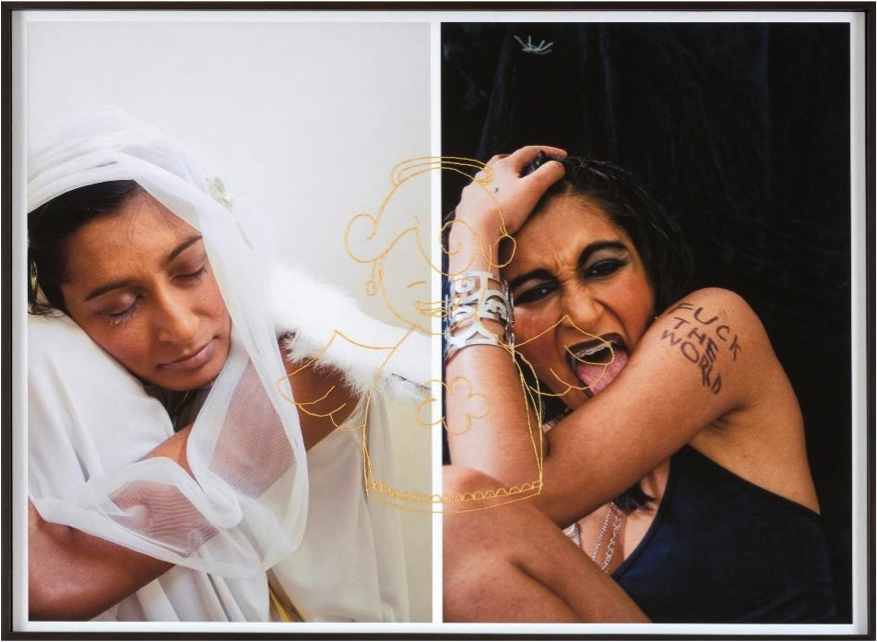
Fuck the World, 2008
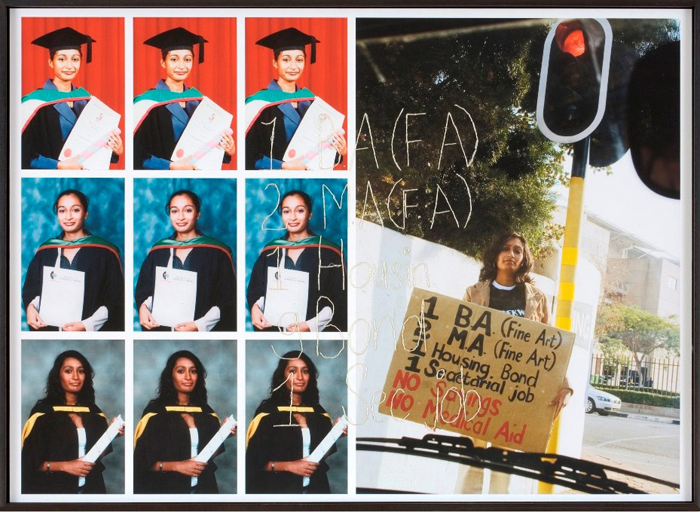
Postgraduate Beggar, 2008
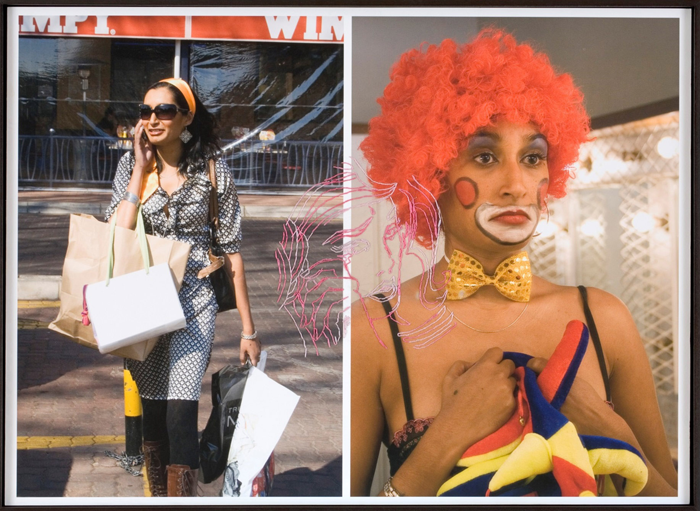
Lonely Socialite Seeks Lonely Socialite Seeks Companion, 2008
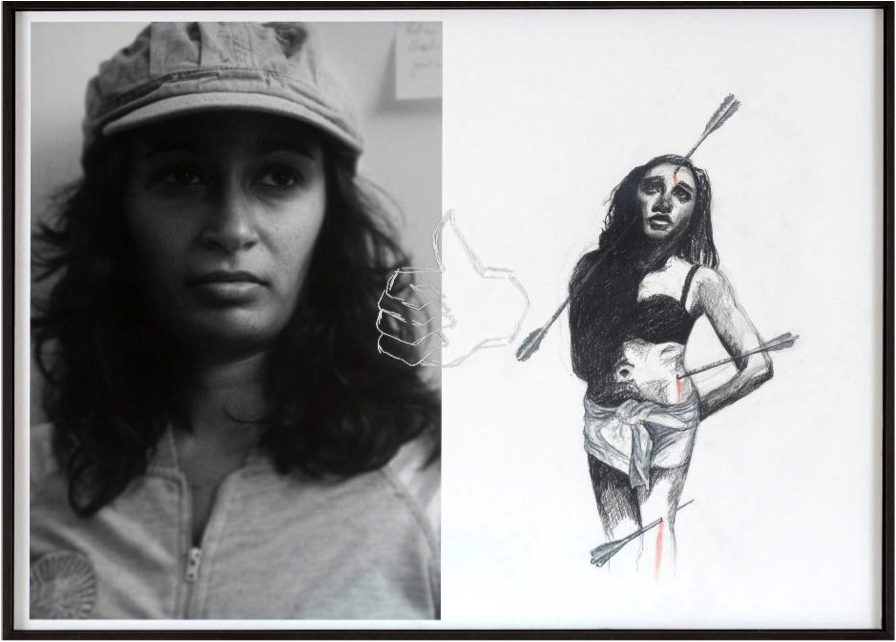
Anybody but Sharlene, 2008
Autobiography and the use of my body in masquerade to dress up in excessive caricatures of Self and Other became the vehicle by which I reclaimed my voice,
my visibility, my position and right to speak against the art industry and academia, which showed in a variety of ways the long arm of power.
[PERFORMATIVE PAUSE. BREATHE. SILENCE]
It started off as a reaction to my silencing.
An international collaborative project, the German curator leaving Johannesburg saying that I didn't need to show my new performative video in Berlin
because "we've already seen all that".
They'd already seen all of that.
Already seen all of that?
Feeling that my voice and language were deemed insufficient, I restaged John Baldessari's iconic I Am Making Art (1976) into a declarative statement:
I MAKE CONTEMPORARY ART
I Make Art from Sharlene Khan on Vimeo.
Using the language of acknowledged canonised works, my repetition become a marker of difference, of otherness, a s-t-r-a-i-n-e-d signifier as I tried to mimic the ephemerality of Baldessari's nonchalant gestures. My body refused to mimic the authority of whiteness, of maleness and I was, yet again, an Other on the margins attempting to force my way into the Western art centre, like those feminists, those Arabs, those Africans, those performers, those public artists, those new media people. Mimicry became mockery in the space of almost-but-not-quite, almost-but-not-white, almost-but-not-right.[iii] The slippage of the not-quite became a space of play, of humour, of popular culture spoofing, of the carnivaleque, the first fart joke, blackface, the space of Homi D. Clown.[iv]

I make art, I make art, I make art, I make art, I make art, I makoe art, I make art, I make art, I make art, I make art, I make art. I make art, I make art, I make art, I make art, I make art, I make art, I make art, I make art, I make art, I make art, I make art, I make art, I make art, I make art. I make art, I make art, I make art, I make art, I make art, I make art. I make art. I make art. I make art.[v]
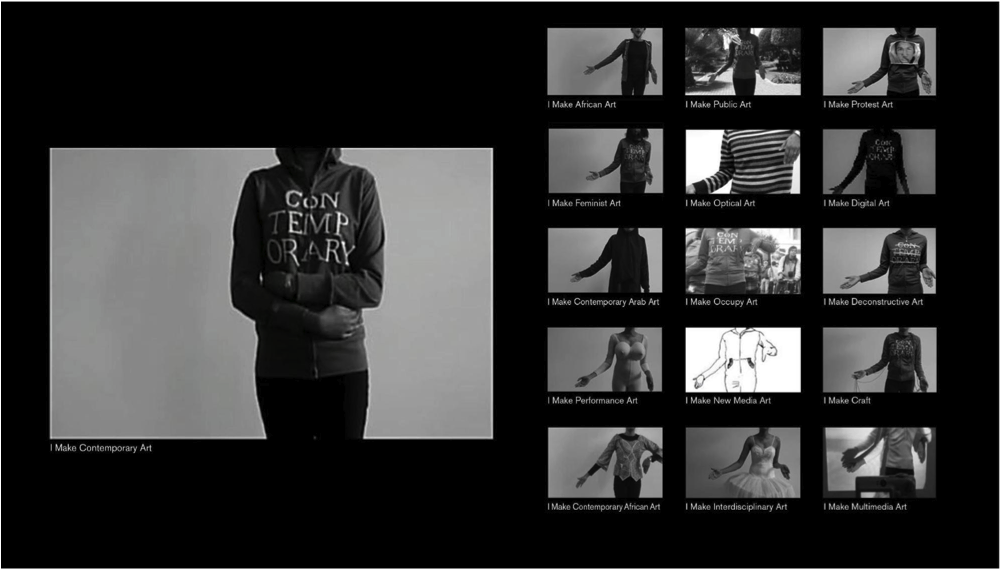
I Make Art, work-in-progress
Repetition re-authorises, but not-quite. It slides, it slips, it tries to hide and it exposes.
Spot the difference. Spot the difference.
Repetition disrupts. Repetition renews. Repetition rejuvenates. Repetition regenerates. Repetition avenges.
[PERFORMATIVE PAUSE. BREATHE. SILENCE]
It started off as a reaction to my silencing.
An encounter with a person in a position of power over me - my decision not to work with someone I didn't feel comfortable with being ignored, my concerns
trivialised. Reduced to a voice I didn't recognise {LIKE ME, LIKE ME}, one that was small, weak, accommodating {LIKE ME, LIKE ME}, wanting to be liked
{LIKE ME, LIKE ME} and not be perceived as a 'troublemaker', yet again.
Not again!
Not this time.
Critique us she said. So I did, but not in written discourse sandwiched amongst other people's thoughts and three syllable catch-phrases. In my words rather, uninhibited, unrestricted, unmediated, raw
- do you believe that?
Fanon's idea of the racially epidermalised body fractured, sent on the four winds by the language of racism, essentialised, fixed in its history, its
ancestors, its appearance became the chosen visual iconography: a set of eyes to gaze at, a gaze that looks back.[vi]
I SEE YOU.
A set of hands wringing in despair, anxiety (menace?). Fragments of a captive body and a maddened mind, a language, a discourse: Subaltern, Alterity, Centre, Margin, Glocal. Sartre prophesied, "What then did you expect when you unbound the gag that muted those black mouths? That they would chant your praises? Did you think that when those heads that our fathers had forcibly bowed down to the ground were raised again, you would find adoration in their eyes?"[vii]
Nervous Conditions I 11 min excerpt from Sharlene Khan on Vimeo.
***
[SCREEN 2: VOICE-OVER]
And then that anger turns into a rage and it's the kind of rage you hide, the rage you have to mask, because you know the people in charge, in power can't
handle that kind of rage, they can't handle your perspectives, your criticism and so you feel the need therefore to mask everything - to mask yourself -
[SCREEN 2 VOICE-OVER: CLOSE, HIDE, CONCEAL]
- so that you fit into this structure and you end up putting on this entire performance even when it is not explicitly asked for and you hate yourself
because you have become 'complicit' in hegemonies so that you can 'get through', so that you can succeed, eventually. But I think part of the fallacy is
believing that it is not asked for because even if such things are never uttered, they become the unspoken and unwritten scripts that are still performed
to keep up appearance.
[SCREEN 3: DO, DO, DO!!!]
[SCREEN 2 VOICE-OVER: SHE SAID YES, SHE SAID NO]
But what if you don't fit in and you don't want to mask it? What if you choose to challenge them, to push back?
[SCREEN 1: NO, NO]-simultaneously-[SCREEN 3: NO, NO]
Are they able to accept this?
[SCREEN 3: NO, NO]
Can they incorporate this or is the only possibility available to shut down and disavow my blackness and my rage?
And no, my rage is not an eligible one. It is not one that I cannot articulate. It is not just symbolic violence but rather it is a violence that has been
put upon us as colonised subjects. More than half of my life I was subjected to White Afrikaner indoctrination in various forms and having come out of
apartheid I have had to question so much of who I am, what I am, what am I doing and why?
[SCREEN 2 VOICE-OVER: WHO AM I? WHERE DO I COME FROM? WHAT AM I DOING IN THIS WORLD?]
Why this way? For whom? What is this really about? This endless questioning in this sea of ignorance. And this questioning leads to this raging about why
we have accepted certain things and why things go unquestioned for as long as they did; how could I not know; why did you allow this; what did you do?
[SCREEN 3: WHY?! HOW COULD YOU? YOU STUPID IGNORANT BITCH! I HATE YOU.]
And that rage has grown and it kind of starts to creep out of you because there is so much to be angry about every day… Every. Single. Day. I think
what Western feminism has done is to speak of rage but in an academic manner, to sanitise and neutralise it and make it palatable so that it becomes
currency so that you can get a book publishing deal, and get your paper published and people invite you to conferences and it's all nice, cause nobody
one's to deal with a raving bitch let alone the angry black woman. I mean rather than screaming at somebody and saying 'this is not how I want to be
treated'…
[SCREEN 3: THIS IS NOT HOW I WANT TO BE TREATED]
…and effecting a change right there and then (even them hating you openly is a change I think), noooo. You have to take it to dinner, have a polite
conversation with it and even pay for supper. I mean confrontation is a part of everyday life but instead with such important issues like race we have to
negotiate, we have to hear that other person's point of view and understand 'where they came from'. What you can hope for at the most is that they resort
to a masquerade of their own were they pretend to tolerate you for a given time in the hope that eventually you will shut the fuck up or even better still,
leave their world untouched when you finally depart.
It's their world. It's always their world. And you're always a visitor who has to learn the house rules. And you learn this shit from the time you're born, even if you're born in a black majority country, only being exposed to other Indian people. Everyone wants a Barbie - you got to get a Barbie. She's a princess, she's beautiful. Look at her long pretty blonde hair (just like Shirley Temple's blonde curls) and which you can comb and comb. And her sparkly blue eyes and small nose and pretty pink mouth. And look at that pretty pink pony she has and the pretty pink carriage that carries her and Ken to a happily ever after. And look at her dress, oh look at her dress. But you can't afford Barbie. You beg and plead but that stupid doll eludes you. Instead you get little baby dolls with their stupid little bonnets and stupid plastic bottles with which you can feed them and then they pee all over you as the water runs right through them. And the ugliest little doll with a horrible head of hair and a head bigger than her whole body lies in a peanut shell. And then the hair gets matted and can't be combed and sits like this big clump which is slightly removed from the plastic scalp, and then the dolls eyelids go weird and one always hang limply and an arm pops out and the doll looks like this thing that accuses you of not taking care of it and the stupid loop keeps saying 'mama mama' and you can't turn it off and you need a stone to break the back open and bang it shut, and you finally do and it stares with its half-opened eye silently, watching. Always watching.
Not like Barbie at all who always remained posed, dignified, even when you stripped her off all her clothes, she still stood there smiling in her
nakedness. Always that smile, perfect, like Dorothy from the Wizard of Oz or Anne of Green Gables or Miss South Africa. Miss South Africa always looked
like a real life Barbie - beautifully white without a scar, long flowing blonde or brown hair, blue or green eyes, long white hairless legs and graceful
white arms, pearly white teeth. She looked great in a swimsuit and in evening gowns and I bet you that if you undressed her she would also stand there
smiling in her beautiful white nakedness. I wished so much that when I grew up I would be white and every night I dreamed that when I grew up I would be
this beautiful white girl named Cristina (Chris for short which would cause all sorts of delightful confusion), and I would have long blonde hair and blue
eyes and a perfect built and I could sit at a pool and be white and beautiful and if I chose to dive into the water, I would rise gracefully and one day I
would meet the love of my life and he would be impressed by my whiteness and my swimming and cycling and skiing and diving and snorkelling, my singing and
dancing.
Because as beautiful as Barbie was, she still couldn't dance as well as all those Bollywood actress - Madhuri Dixit, Sri Devi, Pooja Bhatt, Dimple Kapadia.
They were flawless too, with big brown eyes and ample breasts and curvy hips which could shake in all directions as they danced. They could dance! And they
sounded like angels. And even when they cried, it looked sooooo beautiful. I would have settled for being one of them.
But I wasn't. I wasn't Barbie beautiful or Bollywood beautiful except in my dreams. I was a painfully skinny, hairy, big nosed, crooked teeth girl with all
sorts of scars on my legs left by god knows what poor people's diseases, and when I became a teenager I was introduced to the joys of acne and the ugliest
square glasses - like the ones all the scientists in 70s and 80s sci-fi movies wear. Acne - what acne?, that will stop with age? See a specialist, no, not
necessary. Here's an ointment. Maybe you have too much heat in your body. And of course I couldn't run, jump, bike or swim to save my life. To top it off I
had a too big attitude and not enough reverence for anything. At 16 I got contact lenses and they were coloured blue and in some small way I made Cristina
come true. And when she did, I realised how stupid other people became - they would look at my eyes and were truly impressed. Guys suddenly became
interested, not just in my eyes but in my lineage - do your parents have blue eyes, did your grandparents have blue eyes? Does it run in the family? I
hated them. I hated myself.
[SCREEN 2 VOICE-OVER: HATE, HATE, HATE *whispering*]
And I learnt to hate Miss South Africa.

Always their house, their rules. What did it matter if I knew other stuff about the Ramayana, or the Bodhissativa Padmapani or Tagore or Lata Mangeshkar
and Kishore Kumar? No, it had to be Shakespeare's Macbeth and poems about Irishmen dying and gyrating circles heralding the fall of things. I had to learn
'Oh Susanna', 'Jimmy Crack Corn', 'Old Folks at Home' and stupid songs about yellow submarines and 'ob-la-di-ob-la-da'. I had to hear about die "bobbejaan
who klimmed die berg" and to "borsel my tande tarieps taraps" and "Ons vir jou Suid Afrika". ♫
[SCREEN 2 VOICE-OVER: TARIEPS, TARAPS, TARIEPS, TARAPS]
[SCREEN 3: BOBBEJAAN KLIM DIE BERG SO HASTIG AND SO VASTIG…, TARIEPS TARAPS…, EK BORSEL MY TANDE TAROU…, ONS VIR JOU SUID AFRIKA! ♫]
I had to learn about weird little girls covering their brother in the snow with their naked bodies and Paul Kruger's fucking thumb being shot, and the
pyramids of Giza and flying buttresses in Gothic architecture, and boring Irma Stern and about Gandhi's Satyagraha campaign against the bloody British but
not one word about children being massacred in Soweto or golden rhinos being forged in old fires in the south. They teach you for years to learn to sew,
stitch and mend and then when the country's ripped apart and you're now having to learn 'Nkosi Sikelel' iAfrika' and the new English last part and welcome
Nelson and Winnie and you're looking around thinking - how could I have not known? Why didn't anyone tell me? How? How? How?
[SCREEN 2 VOICE-OVER: HOW, HOW, HOW *in crying voice*][viii]
***
Did you think that I would sing your praises when last I opened my mouth? What did Ama Ata Aidoo call us: 'Sister Killjoy'?[ix] What does sister Sara Ahmed
call us - 'feminist killjoys', enders of that 'good feeling', the promise of happiness, of diversity, the ones who bell hooks says makes backs harden and
brings a hush to a room of liberals and radicals.[x] And yet they call on us to activate the angry black woman stereotype, to use negativity as a radical
methodological tool which sparks a reaction, which sets people off, which is a starting point of creativity as we work out ourselves, our traumas, our
otherness. Anger as a mask, a distance that affronts and still seduces, that pretends at a familiarity even as it forces back. Self-reflective emotion,
neo-didacticism. Who am I speaking to? YOU, and YOU, and YOU and YOU. And me. Not for the purposes of a re-wounding: I tell you my pain-you tell me your
pain, I tell you my pain-you tell me your pain, I tell you my pain-you tell me your pain, I tell you my pain-you tell me your pain, but rather locating
that pain within history, societies' institutions, cultural beliefs and economies, as well as one's own personal Freudian pathologies. Not as a hierarchy
of oppressions…
1. Race
2. Class
3. Gender
4. Sexuality
5. Nationality
6. Religion
7. Education
8. Disability
9. Age
… but in an understanding that in my life these positions slide-slip-intersect-interlock-interweave.[xi] South African Indian woman-of-colour artist, half Muslim-half Christian, heteronormative, poor black middle-class wannabee. Unhomed.[xii] Not White, not Black, not Coloured.[xiii] Not 'fly'. ☹ Homeless. Subaltern. Apartheid's child, post-apartheid's post-modern R&B girl-woman, neo-colonialism's visual artist. Neither here nor there, but somewhere, something, someone else. A space of uncertainty, of ambivalence, of hybridity. A journey of wandering to come back to oneself, the Self that never is without an Other - can one be one's Other? A doppelganger of creativity?
Nervous Conditions II excerpt from Sharlene Khan on Vimeo.
[PERFORMATIVE PAUSE. BREATHE. SILENCE]
Neither one nor the other, someone, something else. A space of ambiguity, of impurity, of ambivalence. What is this space? What is this mask? What is this postcolonial masquerade?[xiv]
No Place from Sharlene Khan on Vimeo.
***
SCENE 3: GARDEN [EMMERENTIA][xvi]
DOROTHY
Toto - I've a feeling we're not in Kansas anymore.
DOROTHY
We must be over the rainbow!
[Shot in colour to represent new SA - Mandela democratic elections]
ACT 2:
Glinda, the 'Good' Witch of the North appears.
GLINDA
I'm Glinda, the Witch of the North. Ding Dong! The Wicked Witch is dead!
[Images of UNESCO speeches and Miriam Makeba speaking to security council]
'Wicked' Witch of the West appears.
WITCH
Who killed my sister? Who killed the Witch of the East? Was it you? Answer me!
[Flicker through images of killed 'Communists' Che, Dulcie September, Biko, Chris Hani, Patrice Lumumba]
DOROTHY
No -- No! It was an accident! I didn't mean to kill anybody!....
WITCH
Give me back my slippers! I'm the only one that knows how to use them. They're of no use to you! Give them back to me!
[Flicker through images of American presidents]
WITCH
I'll get you, my pretty, and your little dog, too!
DOROTHY
Oh, I'd give anything to get out of Oz -- but which is the way back? I can't go the way I came.
GLINDA
No - that's true. The only person who might know would be the great and wonderful Wizard of Oz himself!
DOROTHY
But, how do I start for Emerald City?
GLINDA
It's always best to start at the beginning -- and all you do is follow the Yellow Brick Road.
[INSTRUMENTAL MUSIC 'FOLLOW THE YELLOW BRICK ROAD' - IRIS OUT][xv]
***
My space: the space of the 'after', the new, the crossroads of capital, history, culture, the 'chaotically pluralistic but internally coherent'[xvii]- AFRICA! The space where content-meets-genre-meets-aesthetics-meets-production-meets-money, or rather the lack thereof, meets-audience-meets-foreign-cultural-institutes-meets-fong-kong-distribution-networks-meets-rampant-consumerism-amid plentiful-resources-amid-plentiful-foreign-divestors-meets-poverty-unemployment-disease-illiteracy-poverty porn-and-detrimental aid. What is the postcolonial masquerade? What is my postcolonial masquerade? It is a politics of aesthetics, a politicisation of aesthetics MEETS all that intersects in the postcolonial's life. It takes not content, genre, medium, production, reception and market for granted, but examines these as they inform the aesthetics and discourses that talk to postcolonials first, to those Other people up there (up here) in the North, second. It pretends, it mimics, it seduces, it plays, it laughs, it farts, it gestures, it questions, it interrogates, it interrogates, it interrogates. It speaks loudly. To itself, to its community. Sometimes it has to shout. It whispers, lovingly. It dresses up and appears, simply to disappear and emerge among ambiguities. It is even, even as it is not.
Notes
i A different version of this performative writing piece is presented in my artist catalogue I Make Art (2014).
ii Sharlene Khan, What I look like, What I feel like (in order of appearance): Fuck the World, Postgraduate Beggar, Lonely Socialite Seeks Companion, Anybody but Sharlene, all works are mixed media digital photographs on Entrada (including embroidery, embossing, charcoal, painting), 61cm x 84xm, 2008
iii Inspired by postcolonial theorist Homi K. Bhabha's idea of colonial mimicry and the "almost-but-not-quite."
iv Character from the American TV parodic series In Living Color (1990-1994), created by Keenan Ivory Wayans.
v Sharlene Khan, I Make Art (work-in-progress). Two channel Black and White wall-to-wall video projection with sound (running Time: 2:02 mins), one Black and White DVD with sound playing on free standing TV, one 10 metre wall drawing.
vi Fanon 1952/2008
vii Sartre 1948/1964
viii Sharlene Khan, Nervous Conditions (2015) made up of Nervous Conditions I (2013) a three channel Black and White wall-to-wall digital projection with sound (running Time: 30:07 mins) and a TV DVD display; Nervous Conditions II (2015) and a Black and White digital projection with sound (running Time: 25:53 mins); and Nervous Conditions III (2014) a Black and White digital projection with sound (running Time: 04:00 mins).
ix Aidoo 1977
x Ahmed 2010
xi This is based on black feminist theories around intersectionality and the understandings of intersecting, interlocking oppressions by Audre Lorde, bell hooks, Patricia Hill Collins, Kimberle Crenshaw, etc.
xii This term is appropriated from Bhabha's The Location of Culture.
xiii South African official racial categories
xiv This term is appropriated from cultural scholar Niti Sampat Patel, although she doesn't apply the term to visual art productions.
xv Sharlene Khan, No Place (work-in-progress). Colour video projection with sound and sculptural installation (running time: 22:55 mins).
xvi Script based on the script for the feature length film The Wizard of Oz (1939). Available at: http://www.wendyswizardofoz.com/ (accessed 18/04/12).
xvii Mbembe 2001
Works Cited
Ahmed, Sara. The Promise of Happiness. Durham: Duke University Press, 2010. Print
Aidoo, Ama Ata. Our Sister Killjoy: or Reflections from a Black-eyed Squint. London: Longman, 1977. Print
Bhabha, Homi, K. The Location of Culture. London: Routledge, 1994. Print
Fanon, Frantz. Black Skin, White Masks. 2nd Edition. Trans. Charles L. Markmann. London: Pluto Press, 1952/2008. Print
In Living Color, Produced by 20th Century Fox and Ivory Way Productions. 1990-1994. TV Series.
Khan, Sharlene. "I Make Art - Voicing Voice, Speaking Self and Doing Criticality." I Make Art. Ed. Fouad Asfour and Sharlene Khan. Johannesburg: Sharlene Khan, 2014. 4-19. Print.
Mbembe, Achille. On the Postcolony: Studies on the History of Society and Culture. California: University of California Press, 2001. Print
Patel, Niti Sampat. Postcolonial Masquerades. Culture and Politics in Literature, Film, Video, and Photography. New York: Garland Publishing, 2001. Print
Sartre, Jean-Paul. "Black Orpheus". The Massachusetts Review. Trans. John McCombie. Vol. 6, No. 1 (Autumn, 1964 - Winter, 1965): 13-52. Print
Return to Top»
